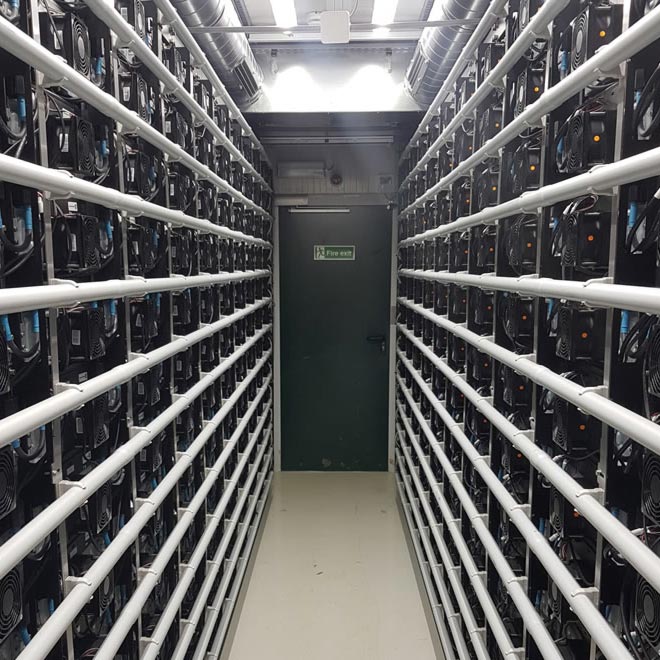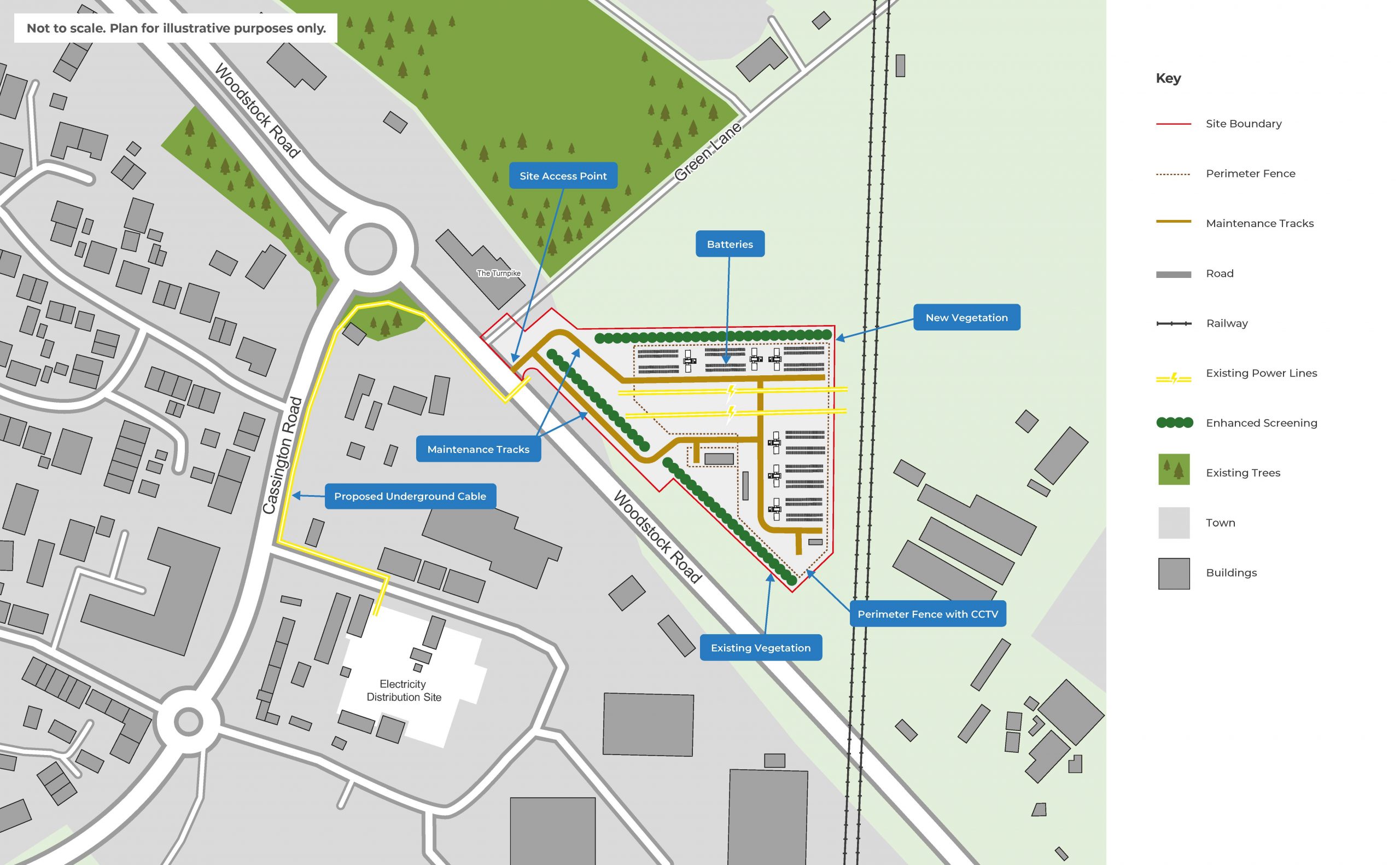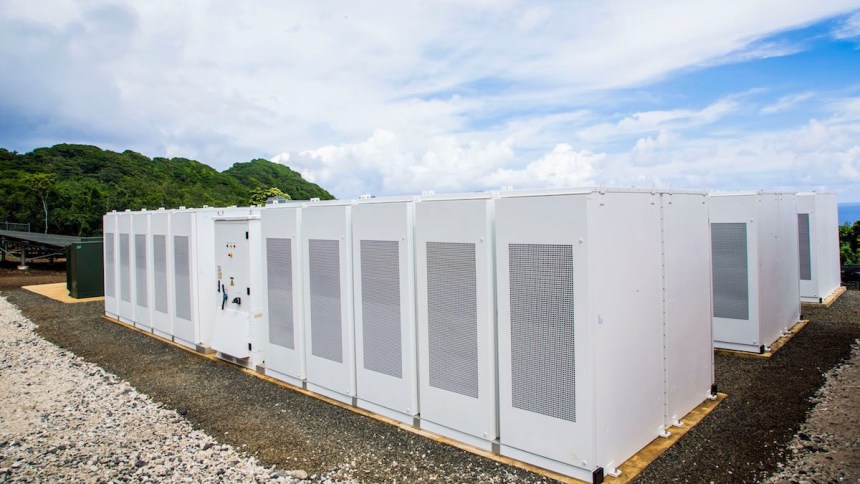YARNTON
BATTERY STORAGE
Renewable Connections Developments has received planning consent for a Battery Energy Storage System (BESS) up to 52MW near Yarnton, Oxfordshire. Once operational, the BESS will enable energy from renewable generation sources such as solar and wind to be stored and released as required. Energy is released from the battery storage system during peak demand, keeping electricity flowing and costs down. This will help to tackle the climate emergency in Oxfordshire by increasing the utility and reliability of renewable energy sources.
- Battery storage has a key role to play in ensuring homes and businesses can be powered by renewable energy sources, even when the sun isn’t shining or when the wind isn’t blowing.
- Batteries help to manage the peaks and troughs of energy demand, supporting a more stable and reliable national electricity grid that is capable of delivering the transition to decarbonised transport and heating needed to meet the country’s net zero goals.
- The UK Government estimates that the implementation of battery energy storage systems could save the UK energy system up to £40 billion in operating costs by 2050, which will help to reduce individual energy bills.
Prior to submitting a planning application to Cherwell District Council, Renewable Connections undertook consultation to inform the local community of our proposed plans and invite feedback on the proposal that could improve our design. We hosted a Virtual Q&A event in August 2024.

LOCATION
The site for the Yarnton Battery Energy Storage System (BESS) comprises approximately 1.5 hectares located on land to the east of the A44 (Woodstock Road), Yarnton.
The site is enclosed and bound by Woodstock Road to the south, Green Lane to the north and west and a railway line to the east and the site is accessed via Woodstock Road.
OUR PROPOSALS
Once installed, the BESS will have a capacity of up to 52MW of electricity storage and will be operational for up to 40 years. After this time, the installation will be removed in its entirety and the land will be restored to its previous use.
The battery project will include state-of-the-art Lithium Iron Phosphate (LFP) battery technology, comprising battery storage modules aligned in rows supported by transformer and inverter platforms.
The transformer and inverter platforms will be connected via underground cables, as will the point of connection, to the existing Yarnton Battery Storage Proposal (BSP). A 2.1m high perimeter security fence will enclose the site, and will include free-standing CCTV cameras with infrared lighting pointing inwards towards the site only, to ensure the safety and protection of the BESS equipment.
PROJECT TIMELINE
STAGE 1
Site selection
Spring 2022
STAGE 2
Preliminary Surveys
Spring 2022
STAGE 3
Pre-application
Spring 2022
STAGE 4
Community Consultation
Summer 2024
STAGE 5
Planning Application
Summer 2024
STAGE 6
Construction
Summer 2026
THE NEED FOR THE PROJECT
Following the Government’s declaration of an “Environment and Climate Emergency” in May 2019, the Committee on Climate Change (CCC) advised that to meet ‘Net Zero’ targets, the UK will require substantial amounts of new, low carbon power sources to be built before 2050, up to four times that of today’s levels.
Cherwell District Council declared their own climate emergency in July of 2019 acknowledging that urgent action is required to limit the environmental impacts produced by the climate crisis. The Yarnton Energy Centre can help support delivery of the Council’s climate objectives.
FAQ’s
How do battery energy storage systems work?
Advanced technology battery storage systems can be charged by electricity generated from renewable energy, like wind and solar power. Intelligent battery software uses algorithms to coordinate energy production and computerized control systems are used to decide when to keep the energy to provide reserves or release to the grid. Energy is released from the battery storage system during peak demand, keeping electricity flowing and costs down.
Why not use nuclear power instead of battery storage?
Whilst nuclear power stations are able to generate a large and consistent amount of electricity for baseload operation, they are very expensive to build and operate and are unable to react quickly to fast-changing grid fluctuations. On the other hand, BESS is able to respond to changes in the grid quickly and makes it possible for cheap renewable energy to be used during times when it wouldn’t normally be possible. For this reason, to improve the stability of the grid network and to facilitate the transition to net zero it makes more sense to invest in BESS rather than nuclear power.
Why this location?
This site has been identified following extensive site selection across Oxfordshire which took into account environmental designations, local electricity network access and capacity, the physical characteristics of the site, and a supportive landowner.
Will there be any impacts on local roads?
For a period of approximately 16-20 weeks during construction, there will be deliveries of equipment to site. Renewable Connections will put in place measures to manage impacts of construction traffic and these measures will be included in a Construction Traffic Management Plan that will submitted with the planning application. There will be infrequent maintenance visits to the site during operation.
Will there be any permanent impact?
No – the Yarnton BESS would operate for a period of up to 40 years, following which the site would be fully decommissioned and returned to its pre-existing use as a storage yard for the neighbouring garden centre.
Do batteries pose a health risk?
No – LFP batteries (or Lithium Iron Phosphate) will be used in the Yarnton Energy Storage System. LFP batteries are thermally and chemically stable, with no risk of fumes or gas leaks. They are made of abundant, non-toxic materials like iron, copper and graphite so have a lower environmental impact from mining, processing and recycling.
Are the batteries noisy?
No – the battery energy storage system will generate some low-level electrical noise from the inverter, switchgear and fans, however the noise impact for people living near the site is negligible. A noise impact assessment will be commissioned as part of the planning application submission.
Are the batteries safe?
The battery storage modules are designed to have a very low risk of failure, and an even lower risk that any failure would result in a fire. Fire detection and fire prevention equipment is installed in all the battery storage modules. All modules are also equipped with an inert gas suppression system and comprehensive monitoring system.
GET IN TOUCH
yarnton@renewableconnections.co.uk
Telephone: 0800 254 5011
Yarnton Energy Centre Limited,
LDN:W,
3 Noble Street,
London,
EC2V 7EE
Renewable Connections is committed to respecting your privacy and to complying with UK data protection and privacy laws. Our privacy policy explains how we collect, use, share and protect personal information.


